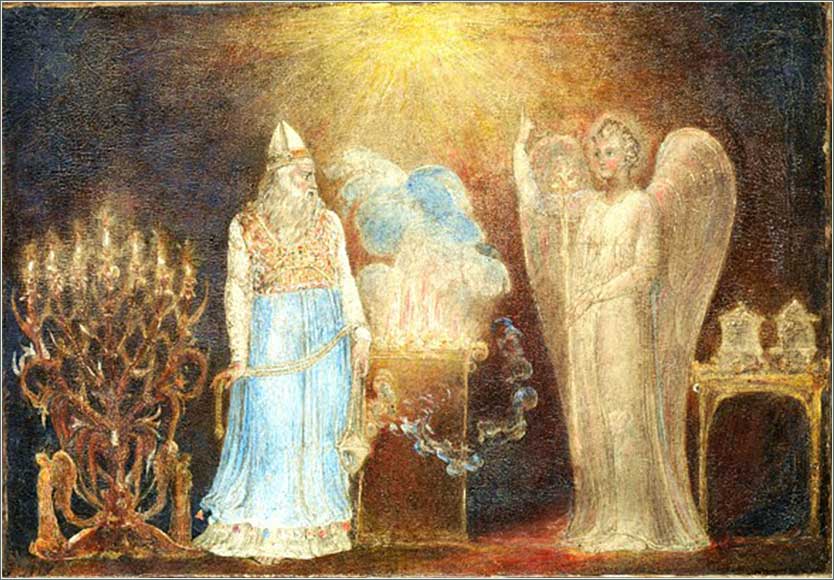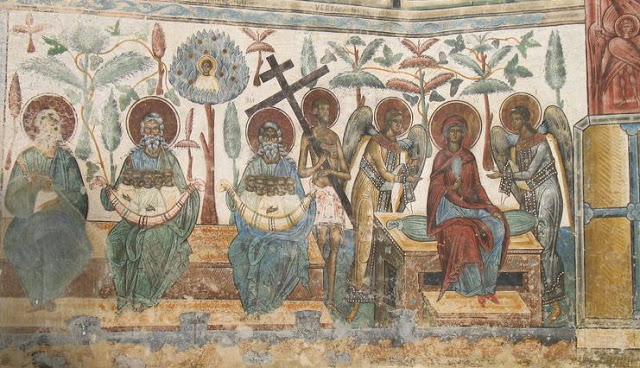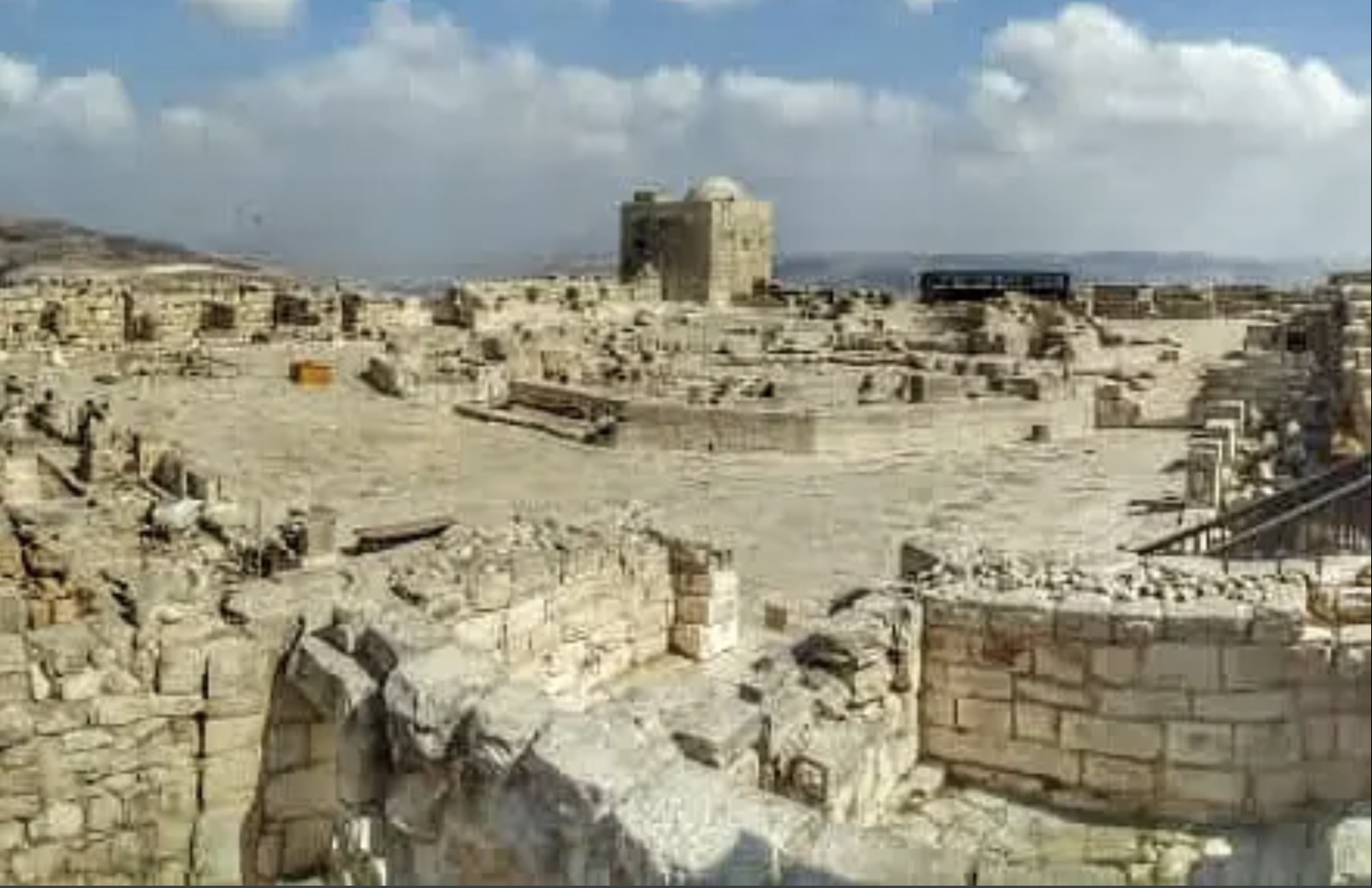
Mark 16:9-20 (Matins)
Hebrews 6:13-20
Matthew 23:29-39
"But You Were Not Willing!"
"How often I wanted to gather your children together, as a hen
gathers her chicks under her wings, but you were not willing!"
In the Name of the Father and of the Son and of the Holy Ghost.
Amen.
The master story of the Hebrew tradition
is the story of Abraham and Sarah.
It is a master story of Christianity, as well.
They are the Patriarch and Matriarch.
The central thread of that narrative is the gift of a child in extreme old age
as the sign of faithfulness:
|
Therefore it is of faith that it might be according to grace,
so that the promise might be sure to all the seed,
not only to those who are of the law,
but also to those who are of the faith of Abraham, who is the father of us all.
(Rom 4:16)
|
Abraham is the exemplar of that central act of the
the Christian life,
which is theosis.
For the story of Abraham and Sarah, above all,
is the story of journey and profound transformation,
passing through the purgation, illumination, unto unity with God.
Having been worldlings of Babylon,
that hated city of paganism,
they depart into the wilderness in order to follow God,
becoming purified,
and
claiming their Divine birthright.
In their biography we find the essential elements of true religion:
of encountering God
of turning away from worldly riches
of eschewing the city life
of life in deserts and wildernesses
of purification
of waiting and of spiritual discernment
of faithfulness in adversity
They are the faithful Adam and Eve.
They have fought the good fight, they have finished the race, they have kept the faith
(cf. 2 Tim 4:7).
Their old age attests this.
By contrast,
as St. Irenaeus has written,
our would-be Patriarch and Matriarch squandered their opportunity,
were found to be unfaithful.
They stumbled in their youthful haste and rashness.
For old age alone (and then death) can evince who and what we really are.

The legacy of Abraham was enshrined in the First Temple of David and Solomon.
For here the journey and ascent we call theosis was formalized into ritual.
The priest entered the area thought of as Eden
and
thence into the Holy of Holies, where one-ness with God was attained.
The Christian depiction of this is expressed in the topos,
attested by Jesus,
of the Bosom of Abraham (icon posted on our website).
Here we see the Three Patriarchs ensconced in Eden
with the Man of Eden,
John the Baptist,
together with the Most Holy Theotokos and all angels.
Here is the Christian story:
the encounter with God;
the calling;
the injunction to leave the world, being in it but not of it;
faithfulness in adversity;
protecting our essential purity, goodness, and Divine birthright;
and
finally arriving to the one-ness with God .... that we might be One even as Jesus and the Father are One (Jn 17:21-23).
As
we have contemplated
on many Sundays,
ancient Israel was a land of two religions during the centuries leading up to Jesus' birth.
The first was the religion of Three Patriarchs.
The scene of its full flowering was the First Temple.
Let us call this the Hebrew religion
—
the holy way instituted of God
providing a path to Himself for the people He has chosen.
The second religion
was instituted by Mesopotamian overlords following the Babylonian captivity.
Upon the return of the Judean elite under the auspices of King Cyrus the Great,
a new temple would be built featuring animal sacrifice
as its central act,
following the cult of Marduk, also called Baal or Bel
in Babylon and in Persia.
This religion mirrors the state craft of classical antiquity.
You see, tribute is payed to a greater power,
an offering,
and
the vassal state is held harmless.
But the original religion was one of profound personal transformation
—
departing from fleshly living,
being purged of unworthiness,
receiving Heaven's light through a cleansed spirit,
and
entering profound unity with God.
This is the pattern of
the Habiru people departing from the fleshpots of sensual Egypt:
being immersed in the Red Sea,
being purged in the desert,
being shown the Pillar of Fire (which light had transformed even the physiognomy of Moses),
and
directed to a Land of Promise signifying unity with God.
By contrast the second religion,
instilled in the Judean elite for more than three generations in Mesopotamia,
would be named for their tribe:
Judah-ism.
Its adherents became known as Jews.
A new temple would be built, underwritten by their Persian overlords.
The Jews would speak a new language,
the Mesopotamian language, Aramaic, not Hebrew.
While one-third of the Judean elite had been carried away to Babylon during the sixth century B.C.,
two-thirds remained.
In addition,
the Hebrew people beyond Judah's borders
also
remained
practicing the religion of the Patriarchs.
As God's Son comes on to the scene,
two thousand years after the birth of Abraham,
He would call Hebrew men
for His Disciples
(save one:
Judas Iscariot, whose name is a variant spelling of Judah).
This helps us to understand St. John's use of the phrase the Jews
in his Gospel.
The phrase appears sixty-six times as compared to the 5 or 6 found in each of the other
Gospels.
In this, the Beloved Disciple singles out Jesus' antagonists as being specifically Judean.
Certainly, John is not a Jew, nor are his ten co-religionists.
They would have been more comfortable in Samaria than in the historical tribal area of Judah.
It is noteworthy that the "good Samaritan" of Jesus' parable is set against
officials of the Mt. Zion Temple,
a priest and a Levite,
who could not touch the bloody man lying on the road
lest they become ritually unclean
and
disqualified for sacrificing animals at the altar.

This enables us to understand Jesus' vow to destroy this Mesopotamian temple.
We are able to understand
Jesus' violent encounter with men selling animals for sacrifice.
His complaint is that they have made His Father's house
a house of trade,
an
οικον εμφοριον,
(oikon emphorion),
trading animal sacrifice in exchange for salvation
when
The sacrifices of God are a broken spirit,
A broken and a contrite heart —
These, O God, You will not despise.
(Ps 51:17)
|
The great hero of the Jewish religion is, not Abraham, but Moses,
the animal sacrificer par excellence.
And this is the main charge leveled against Christians:
that
they would take away the customs of Moses.
This was indictment handed down to the Protomartyr, Stephen:
".... for we have heard him say that this Jesus of Nazareth will destroy this place
[the Second Temple] and change the customs which Moses delivered to us."
(Acts 6:14)
|
You see this is the gist of the whole thing
and
the essence of a Divine Shepherd being sent to retrieve the lost sheep.
It is the Second Temple, therefore,
which is
the focal point of tension between the Jews and the Hebrews.
The Jews, for example, would destroy the Temple on Mt. Gerizim a century before Jesus' birth.
For all we know this site featured the rituals, not of animal sacrifice,
but of ritual transformation.
Understanding all this, now we can enter a sound reflection on Zacharias,
who stands at the altar of the Neo-Mesopotamian Temple.
☦
Occupying pride of place over the Jewish party
were the Sadducees,
who "dominated the Temple and its priesthood" (Britannica, "Sadducees").
Like their ancestors who had been formed in Babylonian and, later, Persian religion,
they did not believe in the resurrection or an afterlife.
They did not believe in a living, present, moral God,
Who rewards or punishes human conduct.
And, to our point this morning,
they did not believe in a spiritual realm inhabited by angels.
They did not believe in angels.
Without question,
the priests
serving the Second Temple
were men after the heart of the Sadducees.
Zacharias
is a man very much in the Mesopotamian strain.
He stands at an altar constructed by Persians,
who were
devoted to Baal / Bel.
But a different religious experience than the one he expected is about to unfold.
He is about to encounter God.
He will be enveloped in the energies of an archangel.
And through this decisive encounter,
he will stand on the threshold between two profoundly different worlds:
the world of the First Temple
and
the world of the Second Temple.
It is noteworthy that the Holy of Holies in the First Temple was adorned with angels,
not found in the Second Temple.
Controversy and debate instantly vaporize and disappear
in the burning glare of Divine radiance.
And the Archangel speaks:
|
"I am Gabriel, Who stands in the Presence of God."
(Lu 1:19)
|
In words clearly intended to contrast the adolescent Mary's faithfulness
—
Be it unto me according to Thy word,
—
Zachariah says weakly,
|
"How shall I know this?"
(Lu 1:18)
|
Gabriel has just laid a glorious vision before him:
"Your wife Elizabeth will bear you a son, and you shall call his name John.
And you will have joy and gladness, and many will rejoice at his birth.
For he will be great in the sight of the Lord,
and shall drink neither wine nor strong drink.
He will also be filled with the Holy Spirit,
even from his mother's womb.
And he will turn many of the children of Israel to the Lord their God.
He will also go before Him in the spirit and power of Elijah,
'to turn the hearts of the fathers to the children,'
and the disobedient to the wisdom of the just,
to make ready a people prepared for the Lord."
(Lu 1:13-17)
|
But the Sadducees' priest cannot abide this challenge to his benighted faith
and
questions the archangel's credibility.
In effect,
he says,
"Your logic doesn't add up.
A child?!
That is not possible":
|
"I am an old man, and my wife is well advanced in years."
(Lu 1:18)
|
The subtext here,
of course,
is that angels do not square with the the Second Temple's beliefs.
Angels are not possible.
We are reminded
of Ebenezer Scrooge telling Marley's ghost that he is merely
a hallucination.

The opposition between Zachariah and the adolescent Mary
has been carefully arranged by the great icon painter, St. Luke.
In effect, he has written a diptych.
On the left hand panel we see Mary's parents,
Joachim and Anna,
spiritual heroes of the Hebrew lifeworld.
On the right hand panel we see,
Zacharias and Elizabeth,
who are very much Second Temple people,
of the Sadducees party.
Both couples are aged and barren.
Joachim is a devout man but in a particular tradition.
We do not find him offering sacrifices.
Rather,
|
.... he retired to the desert, and there pitched his tent,
and fasted forty days and forty nights,
saying in himself:
I will not go down either for food or for drink until the Lord my God shall look
upon me, and prayer shall be my food and drink.
(Protoevangelion of James, 1)
|
That is,
after the pattern of Abraham
(and anticipating John the Baptist),
he goes into the wilderness.
He seeks purgation and purification.
He seeks communion with God.
He conforms his life to Divine life making prayer his food and drink.
He seeks transformation.
Anna, the mother of the Most Holy Mother of God,
also
gives herself over to continual prayer,
seeking only communion with God:
|
"Alas! To what have I been likened?
I am not like the fowls of the heaven,
because even the fowls of the heaven are productive before You, O Lord.
Alas! To what have I been likened?
I am not like the beasts of the earth, because even the beasts of the earth
are productive before You, O Lord.
Alas! To what have I been likened?
I am not like these waters, because even these waters are productive before You, O Lord.
Alas! To what have I been likened?
I am not like this earth, because even the earth brings forth its fruits in season, and blesses You, O Lord.
(Protoevangelion of St. James, 3)
|

Their prayers culminate in an encounter with angels.
|
And, behold, an angel of the Lord stood by, saying:
Anna, Anna, the Lord has heard your prayer, and you shall conceive, and shall bring forth;
and your seed shall be spoken of in all the world.
And Anna said:
As the Lord my God lives, if I beget either male or female,
I will bring it as a gift to the Lord my God;
and it shall minister to Him in holy things all the days of its life
(1 Samuel 1:11).
And, behold, two angels came, saying to her: Behold, Joachim your husband is coming with his flocks.
For an angel of the Lord went down to him, saying:
Joachim, Joachim, the Lord God has heard your prayer.
Go down hence; for, behold, your wife Anna shall conceive.
(Protoevangelion of St. James, 4)
|
You see this is background story for Gabriel encountering Mary.
You see this is background story for Gabriel encountering Zacharias.
As with Abraham and Sarah,
the living blessing of a child
is the fruit of their faithfulness,
indeed,
the gateway through which God will enter the human lifeworld.
God enters our world through faithfulness.
Having lived into the journey of Abraham and Sarah ritually,
Joachim and Anna fulfill the Hebrew ideal of faithfulness and final blessing.
How utterly different, then, is the right-hand panel of the diptych.
The right-hand panel is the Jewish version.
Zachariah offers sacrifice in order to appease a greater power,
not yearning for communion with him,
much less a heart consumed with prayer.
Far from praying or opening his heart,
Zachariah is disquieted at the appearance of an angel.
Far from the jubilation and thanksgivings,
Zachariah rebukes Gabriel
and
questions his authority.
These scenes in St. Luke's Gospel do not appear somewhere in the middle.
No,
they constitute the cornerstone.
They are the starting point.
For Luke, this question of two, very much opposed religions
is central the Christian event.
Jesus enters human history in the midst of a civil war
between Hebrews and Jews.
We call this sort of thing "culture war."
Zachariah represents all that is wrong with the new-fangled temple.
Both he and the temple are dead to God.
Intimacy is lost.
Slaughtered animals are a poor substitute for love and the transformation of mankind
unto the Image of God.
☦

Where does the Gospel lesson appointed for today's feast fit in to all this?
Why should
Matthew 23:29ff have been selected for the Feast of Zacharias, Priest and Prophet?
The answer is, intimacy:
|
"O Jerusalem, Jerusalem, ....
How often I wanted to gather your children together, as a hen gathers her chicks under her wings,
but you were not willing!"
(Mt 23:37)
|
The image of the mother and her children is central to the Hebrew message.
Nominally, the chicks will grow into the fullness of the family image,
children being indistinguishable from parents.
The image of the chicks gathered under the wing is one of unity.
But what of the ones who rebel,
who depart from this unity?
Jesus says,
|
"See! Your house is left to you desolate."
(Mt 23:38)
|
The narrative of Zachariah is a precise analogue not only to the history of Israel,
"who murdered the prophets,"
but also of a people who encountered God,
who mocked His credibility,
and
who rebelled against His authority.
The parting words of this Rejected One are chilling:
|
"For I say to you, you shall see Me no more till you say, 'Blessed is He who comes in the Name of the LORD!'"
(Mt 23:39)
|
This word LORD here has been inserted.
The underlying Hebrew is "YHWH,"
Son of the Most High God, El Elyon.
YHWH is the light giver.
YHWH is God:
Blessed is he who comes in the Name of the Lord!
We have blessed you from the house of the Lord.
God is the Lord,
And He has given us light;
(Ps 118:26-27)
|
In the First Temple,
the priest standing in the Holy of Holies
arriving to the high point of transformation
—
the same high point of our Christian,
which is
complete unity with God
—
was greeted with the same salutation:
"Blessed is he who comes in the Name of the Lord."
In the Name of the Father and of the Son and of the Holy Spirit. Amen.





